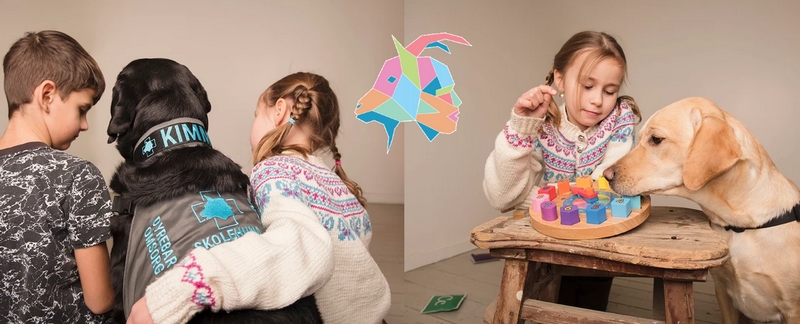
The International Centre of Anthrozoology works within several areas of human animal interactions, including consultancy and practice of animal assisted interventions, education, research and behavior modification and dog training classes. ICofa; @International Centre of Antrozoology; @.dyrebaromsorg.no
It’s the cat lovers’ dilemma. You buy sachets of food that stink out the house, clean out litter trays, and spend hundreds on vet bills. In return, the feline companion scratches your furniture and arms, deposits dead rodents on the carpet, and occasionally disappears for three days.
“With humans, it’s survivor thinking: if I’m nice to people, they will be nice to me,” says Yoni Yehuda, an Israeli psychotherapist, as his cat Jack Daniels licks water from a jug on his office table.
With animals, he says, there is no apparent quid pro quo. We help them for purer reasons, often with no expectation of a return. “It’s giving from something that is very clean inside.”
This concept is the foundation of the professor’s work – providing therapy for people with mental health conditions by asking them to care for animals. There is healing, he believes, deeply rooted in the animal-human relationship. “The first animal-assisted psychotherapist was God,” he says, as a parrot pecks at the mosquito netting on his office window.
Outside, a llama and a camel laze on the sand under the sun. Yehuda has hundreds of animals, from horses and turtles to an exotic Jesus lizard that runs on water and a ring-tailed South American coati. Most were rescued and for various reasons cannot be returned to the wild or re-homed.

The centre and Yehuda’s work is at the experimental – even controversial – end of a scientific field that has become increasingly established and popular worldwide.
Animals were used in mental health institutions in the late 18th century to encourage socialisation. Today, a patient might be given time to stroke a dog, which has been shown to reduce stress. Practitioners say animals can also motivate patients to stay in treatment, or be used as a metaphor for their own struggles. Some traumatised people prefer not to interact with another person at all.
In the past few years, analyses of dozens of studies indicate animals in therapy can have a limited but positive impact on a range of disorders, including depression, schizophrenia and addiction.
“A lot of the studies are not very high quality, but it gives a good view,” says Karin Hediger, a psychotherapist and researcher at the University of Basel, in Switzerland.
For two years, Hediger has run a centre housing horses, rabbits and chickens, working with children and adults with psychological issues. She has found animals can break barriers with patients who struggle to understand how they feel, or even how they act.
If her patients display aggression or frustration, a specifically trained therapy horse can read their body language and respond, often by backing away. “The client realises there is something going on,” Hediger says.

Some patients do not speak. In that case, she says, “it’s perfect to work with animals, because they are non-verbal, too”.
As the field grows, an umbrella group, the International Association of Human-Animal Interaction Organizations (IAHAIO), has sought to promote more and higher-quality research.
“There are effects, and they are scientifically proven. But many of the effects are very difficult to prove statistically because they are on an emotional level,” says the president, Prof Marie-José Enders-Slegers.
“On the emotional level, you see [patients] are relaxed, they have fun, and they are peaceful and they have joy. And that is such a fantastic thing.”
IAHAIO has worked to professionalise the field, implementing professional and ethical guidelines. It banned therapy with exotic species, such as monkeys and reptiles, not only because of potential dangers but risks of transferable disease.
Captive dolphin therapy, in particular, has been condemned by many in the community as inhumane pseudoscience, with little quality research backing it up.
Yehuda is something of a maverick. At his therapeutic centre in a settlement in the occupied West Bank, he has developed his own methods, working with both domesticated and wild animals.
He began his career by using himself as a patient. In 1987, while in the paratroopers, his right side was paralysed, and he was later diagnosed with post-traumatic stress disorder. When he was wounded again after being shot by a Palestinian militant, his mental condition deteriorated.
“I started practising on myself, and trying to understand my feelings, my being,” he recalls.
Yehuda now has a PhD in psychology and runs a well-respected three-year course at Hebrew University. He has several self-designed methods, normally using particular animals for different conditions.

With phobias, he has a programme with stick insects, butterflies, and worms. “If we have problems with eating problems, like anorexia and bulimia, we have a special method to work with iguanas.”
His centre has remained open throughout the pandemic in a limited capacity.
One of his patients, who asks to remain anonymous, says he “started to stop functioning” after fighting for the Israeli army in Gaza during the 2014 war. Sleeping all day and awake all night, he “was on the verge of being hospitalised”.
When he booked into the centre, he expected to be asked questions about his feelings. Instead, Yehuda told him to look after the goats. “I had no interest in animals. I sat for hours with the goats,” he remembers as he walks around the enclosure. “It wore me down physically, helped me to sleep,” he adds. After several weeks, he approached Yehuda as he felt ready to talk, and months later still helps at the centre.
Yehuda says animal-assisted therapy is a “new, living and kicking” field of psychotherapy but that his work is very ancient, even instinctual.
His aim is to make people feel they have a goal in their lives, “even if it is just giving water to a cat”.
guardian.co.uk © Guardian News & Media Limited 2010
Published via the Guardian News Feed plugin for WordPress.

